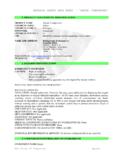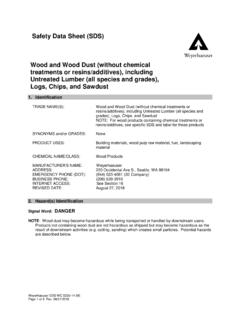Transcription of SAFETY DATA SHEET GEL HAND SANITIZER - UCSF Health
1 SAFETY data SHEET GEL HAND SANITIZER 903709-10 1 / 8 SECTION 1. PRODUCT AND COMPANY IDENTIFICATION Product name : GEL HAND SANITIZER Other means of identification : Not applicable Recommended use : Hand SANITIZER Restrictions on use : Reserved for industrial and professional use. Product dilution information : Product is sold ready to use. Company : Ecolab Inc. 370 N. Wabasha Street St. Paul, Minnesota USA 55102 1-800-352-5326 Emergency telephone : 1-800-328-0026 (US/Canada), 1-651-222-5352 (outside US) Issuing date : 11/20/2014 SECTION 2. HAZARDS IDENTIFICATION GHS Classification Flammable liquids : Category 3 Eye irritation : Category 2A GHS Label element Hazard pictograms : Signal Word : Warning Hazard Statements : Flammable liquid and vapor. Causes serious eye irritation. Precautionary Statements : Prevention: Keep away from heat/sparks/open flames/hot surfaces. - No smoking. Keep container tightly closed.
2 Response: IF IN EYES: Rinse cautiously with water for several minutes. Remove contact lenses, if present and easy to do. Continue rinsing. If eye irritation persists: Get medical advice/ attention. In case of fire: Use dry sand, dry chemical or alcohol-resistant foam for extinction. Storage: Store in a well-ventilated place. Keep cool. Disposal: Dispose of contents/ container to an approved waste disposal plant. Other hazards : None known. SECTION 3. COMPOSITION/INFORMATION ON INGREDIENTS Pure substance/mixture : Mixture SAFETY data SHEET GEL HAND SANITIZER 903709-10 2 / 8 Chemical Name CAS-No. Concentration (%) ethanol 64-17-5 60 - 100 lsopropyl Alcohol 67-63-0 5 - 10 SECTION 4. FIRST AID MEASURES In case of eye contact : Rinse with water. In case of skin contact : Rinse with water. If swallowed : Rinse mouth. Get medical attention if symptoms occur. If inhaled : Get medical attention if symptoms occur.
3 Protection of first-aiders : No special precautions are necessary for first aid responders. Notes to physician : Treat symptomatically. Most important symptoms and effects, both acute and delayed : See Section 11 for more detailed information on Health effects and symptoms. SECTION 5. FIRE-FIGHTING MEASURES Suitable extinguishing media : Use extinguishing measures that are appropriate to local circumstances and the surrounding environment. Unsuitable extinguishing media : High volume water jet Specific hazards during fire fighting : Fire Hazard Keep away from heat and sources of ignition. Flash back possible over considerable distance. Beware of vapors accumulating to form explosive concentrations. Vapors can accumulate in low areas. Hazardous combustion products : Decomposition products may include the following materials: Carbon oxides Nitrogen oxides (NOx) Sulfur oxides Oxides of phosphorus Special protective equipment for fire-fighters : Use personal protective equipment.
4 Specific extinguishing methods : Use water spray to cool unopened containers. Fire residues and contaminated fire extinguishing water must be disposed of in accordance with local regulations. In the event of fire and/or explosion do not breathe fumes. SECTION 6. ACCIDENTAL RELEASE MEASURES Personal precautions, protective equipment and emergency procedures : Remove all sources of ignition. Ensure clean-up is conducted by trained personnel only. Refer to protective measures listed in sections 7 and 8. Environmental precautions : Do not allow contact with soil, surface or ground water. SAFETY data SHEET GEL HAND SANITIZER 903709-10 3 / 8 Methods and materials for containment and cleaning up : Eliminate all ignition sources if safe to do so. Stop leak if safe to do so. Contain spillage, and then collect with non-combustible absorbent material , ( sand, earth, diatomaceous earth, vermiculite) and place in container for disposal according to local / national regulations (see section 13).
5 Flush away traces with water. For large spills, dike spilled material or otherwise contain material to ensure runoff does not reach a waterway. SECTION 7. HANDLING AND STORAGE Advice on safe handling : Keep away from fire, sparks and heated surfaces. Take necessary action to avoid static electricity discharge (which might cause ignition of organic vapors). Conditions for safe storage : Keep away from heat and sources of ignition. Keep in a cool, well-ventilated place. Keep away from oxidizing agents. Keep out of reach of children. Keep container tightly closed. Store in suitable labeled containers. Storage temperature : 0 C to 35 C SECTION 8. EXPOSURE CONTROLS/PERSONAL PROTECTION Ingredients with workplace control parameters Ingredients CAS-No. Form of exposure Permissible concentration Basis ethanol 64-17-5 TWA 1,000 ppm 1,900 mg/m3 NIOSH REL TWA 1,000 ppm 1,900 mg/m3 OSHA Z1 lsopropyl Alcohol 67-63-0 TWA 200 ppm ACGIH STEL 400 ppm ACGIH TWA 400 ppm 980 mg/m3 NIOSH REL STEL 500 ppm 1,225 mg/m3 NIOSH REL TWA 400 ppm 980 mg/m3 OSHA Z1 Engineering measures : Good general ventilation should be sufficient to control worker exposure to airborne contaminants.
6 Personal protective equipment Eye protection : No special protective equipment required. Hand protection : No special protective equipment required. Skin protection : No special protective equipment required. Respiratory protection : No personal respiratory protective equipment normally required. Hygiene measures : No specific measures identified. SECTION 9. PHYSICAL AND CHEMICAL PROPERTIES SAFETY data SHEET GEL HAND SANITIZER 903709-10 4 / 8 Appearance : gel Color : clear, colorless Odor : alcoholic pH : - , 100 % Flash point : 24 C closed cup Odor Threshold : No data available Melting point/freezing point : No data available Initial boiling point and boiling range : No data available Evaporation rate : No data available Flammability (solid, gas) : No data available Upper explosion limit : No data available Lower explosion limit : No data available Vapor pressure : No data available Relative vapor density : No data available Relative density : - Water solubility : No data available Solubility in other solvents : No data available Partition coefficient: n-octanol/water : No data available Autoignition temperature : No data available Thermal decomposition : No data available Viscosity, kinematic : No data available Explosive properties.
7 No data available Oxidizing properties : No data available Molecular weight : No data available VOC : No data available SECTION 10. STABILITY AND REACTIVITY Chemical stability : Stable under normal conditions. Possibility of hazardous reactions : No dangerous reaction known under conditions of normal use. Conditions to avoid : Heat, flames and sparks. Incompatible materials : None known. Hazardous decomposition products : Decomposition products may include the following materials: Carbon oxides Nitrogen oxides (NOx) Sulfur oxides Oxides of phosphorus SECTION 11. TOXICOLOGICAL INFORMATION SAFETY data SHEET GEL HAND SANITIZER 903709-10 5 / 8 Information on likely routes of exposure : Inhalation, Eye contact, Skin contact Potential Health Effects Eyes : Causes serious eye irritation. Skin : Health injuries are not known or expected under normal use. Ingestion : Health injuries are not known or expected under normal use.
8 Inhalation : Health injuries are not known or expected under normal use. Chronic Exposure : Health injuries are not known or expected under normal use. Experience with human exposure Eye contact : Redness, Pain, Irritation Skin contact : No symptoms known or expected. Ingestion : No symptoms known or expected. Inhalation : No symptoms known or expected. Toxicity Acute oral toxicity : Acute toxicity estimate : > 5,000 mg/kg Acute inhalation toxicity : 4 h Acute toxicity estimate : > 40 mg/l Acute dermal toxicity : No data available Skin corrosion/irritation : No data available Serious eye damage/eye irritation : No data available Respiratory or skin sensitization : No data available Carcinogenicity IARC No component of this product present at levels greater than or equal to is identified as probable, possible or confirmed human carcinogen by IARC. OSHA No ingredient of this product present at levels greater than or equal to is identified as a carcinogen or potential carcinogen by OSHA.
9 NTP No ingredient of this product present at levels greater than or equal to is identified as a known or anticipated carcinogen by NTP. Reproductive effects : No data available Germ cell mutagenicity : No data available Teratogenicity : No data available STOT-single exposure : No data available STOT-repeated exposure : No data available Aspiration toxicity : No data available Ingredients SAFETY data SHEET GEL HAND SANITIZER 903709-10 6 / 8 Acute dermal toxicity : ethanol LD50 Rabbit: 15,800 mg/kg lsopropyl Alcohol LD50 Rabbit: 12,870 mg/kg SECTION 12. ECOLOGICAL INFORMATION Ecotoxicity Environmental Effects : This product has no known ecotoxicological effects. Product Toxicity to fish : No data available Toxicity to daphnia and other aquatic invertebrates : No data available Toxicity to algae : No data available Ingredients Toxicity to fish : ethanol 96 h LC50 Fish: 11,000 mg/l lsopropyl Alcohol 96 h LC50 Fish: 9,640 mg/l Persistence and degradability No data available Bioaccumulative potential No data available Mobility in soil No data available Other adverse effects No data available SECTION 13.
10 DISPOSAL CONSIDERATIONS Disposal methods : Where possible recycling is preferred to disposal or incineration. If recycling is not practicable, dispose of in compliance with local regulations. Dispose of wastes in an approved waste disposal facility. Disposal considerations : Dispose of as unused product. Empty containers should be taken to an approved waste handling site for recycling or disposal. Do not re-use empty containers. RCRA - Resource Conservation and Recovery Authorization Act Hazardous waste : D001 (Ignitable) SECTION 14. TRANSPORT INFORMATION SAFETY data SHEET GEL HAND SANITIZER 903709-10 7 / 8 The shipper/consignor/sender is responsible to ensure that the packaging, labeling, and markings are in compliance with the selected mode of transport. Land transport (DOT) UN number : 1170 Description of the goods : Ethanol solutions Class : 3 Packing group : III Environmentally hazardous : no Sea transport (IMDG/IMO) UN number : 1170 Description of the goods : ETHANOL SOLUTION Class : 3 Packing group : III Marine pollutant : no SECTION 15.






